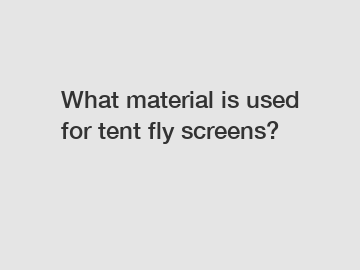What material is used for tent fly screens?
Qicai Knitting Product Page
What material is used for tent fly screens?
Tent fly screens play a vital role in protecting us from pesky insects and allowing fresh air to circulate inside our tents. Choosing the right material for tent fly screens is, therefore, crucial to ensure comfort and maintain a bug-free camping experience. In this article, we will explore the various materials used for tent fly screens, their advantages and disadvantages, and the factors to consider when making a choice.

1. Mesh Material:
Mesh is the most common material used for tent fly screens. It is usually made from either polyester or nylon. Both materials offer excellent durability and are resistant to tears and abrasions. Nylon mesh tends to be stronger and more lightweight, making it ideal for backpacking and hiking tents. However, both polyester and nylon mesh provide sufficient ventilation while keeping bugs out. The fine openings of the mesh prevent insects from invading your tent and disrupting your peaceful slumber.
2. No-See-Um Mesh:
No-See-Um mesh is a high-density mesh specifically designed to keep out smaller insects, such as gnats and midges, commonly known as no-see-ums. These tiny pests can easily pass through regular mesh, causing annoyance and discomfort. No-See-Um mesh features smaller openings, making it an excellent option for camping in more bug-infested areas. This material ensures that even the tiniest nuisances are unable to penetrate your tent and ruin your camping experience.
3. PVC-Coated Mesh:
PVC-coated mesh is a durable and weather-resistant option for tent fly screens. The PVC coating adds an extra layer of protection, making it suitable for rough terrain and extreme weather conditions. PVC-coated mesh offers increased resistance to water, UV rays, and abrasion, ensuring a longer lifespan for your tent's fly screens. While this material may be slightly heavier than regular mesh, it provides extra durability and is a valuable choice for frequent campers or those embarking on more adventurous expeditions.
4. Magnetic Screens:
Magnetic screens are an innovative alternative to traditional tent fly screens. These screens use magnets to create a tightly sealed closure that prevents insects from entering your tent. The magnetic closure automatically shuts after you pass through, ensuring a bug-free environment without the need for zippers or velcro. Magnetic screens are often made from a combination of polyester mesh and magnets, providing both durability and convenience. They are easy to install and remove and are particularly popular for camping setups that require frequent movement in and out of the tent.
Factors to Consider:
When choosing the material for your tent fly screens, it's important to consider a few factors:
1. Weight: If you are backpacking or hiking, opting for lightweight materials like nylon mesh can help reduce the overall weight of your gear.
2. Ventilation: Ensure that the material you choose provides adequate airflow to help maintain a comfortable temperature inside your tent.
3. Bug Density: If you are camping in an area with a high density of tiny insects, consider investing in no-see-um mesh to prevent them from sneaking in.
4. Durability: Assess the durability of the material, especially if you plan to camp frequently or in challenging environments.
Conclusion:
Choosing the right material for your tent fly screens is essential for a comfortable and enjoyable camping experience. Whether you opt for the common polyester or nylon mesh, the specialized no-see-um mesh, the durable PVC-coated mesh, or the convenient magnetic screens, each material offers unique advantages suited to different camping scenarios. Remember to consider factors such as weight, ventilation, bug density, and durability when selecting the perfect material for your tent fly screens. With the right choice, you can ensure insect-free nights and a pleasant outdoor adventure.
Want more information on polyester mesh netting? Feel free to contact us.



